Q&A Free Delivery Versus Reasonable Delivery Costs On Amazon
This is the third of a series of articles where I’m answering several questions that have come in via email in the past few days, that I feel that you’d gain value from hearing the answer too.
Free Delivery Versus Reasonable Delivery Costs
Today’s question is from Christine and is in relation to the having free shipping v’s reasonable shipping costs on Amazon.
The reason why it’s curious is because Amazon is quite different to eBay in the way it organises listing & prices and I’d like to delve into the Amazon Buy Box a little deeper and their prime subscriptions too.
Here’s the question:
Hi There Matthew,
I was just wondering what your thoughts were on Free Delivery versus reasonable delivery costs.
I started selling on Amazon about 1 year ago and have always gone for the reasonable delivery costs option so the actual product price appears a little lower than those who offer Free Delivery.
Even though Amazon calculates the cheapest offer based on a total of product and delivery charges my thoughts are that if a buyer sees a cheaper product cost plus reasonable delivery cost then the perception is that the product is more reasonably priced overall.
However I am considering changing to Free UK delivery for ease of calculating delivery costs etc
Kind Regards
Christine
Price Perception
I feel Christine is right, the perception that a customer would have that the price is good and the shipping is sensible then it would appear as a better proposition overall.
However, we must account for that we would assume this to be logical, but as buyers we’re not logical at all, we’re emotional, plus we are considering the Amazon marketplace here and while this may be true for other marketplaces or on our own websites, for Amazon I don’t think this is true and I’ll explain why.
By the way, if you think I’m wrong, you can let me know in the comments box at the bottom.
The Amazon Buy Boxes
To see where I’m going with this reply, we need to take a look at the buy boxes on Amazon and how the change.
Amazon Only / Amazon Prime
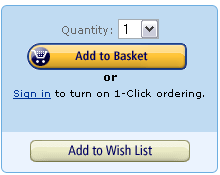 If we take a look at the normal Amazon buy box on for an item that is being sold by Amazon directly, then we can see it’s very clean.
If we take a look at the normal Amazon buy box on for an item that is being sold by Amazon directly, then we can see it’s very clean.
As a buyer we’re presented with just the quantity option, add to basket as the primary action, the option to login or the secondary action of adding it to a wishlist.
All pretty clean.
3rd Party Seller + Free Delivery
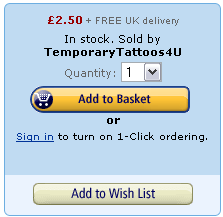
However if we now look at Amazon buy box where there isn’t Amazon and just a 3rd party seller like us, then we can see that the buy box has the extra details at the top about the seller.
We can also see the item price and the shipping amount and the sellers name, noting that the delivery amount is emphasised as “FREE UK delivery”.
3rd Party Seller + Paid Delivery
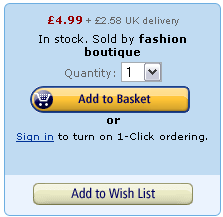 In the buy box to the right, we have a product where the seller has a delivery price entered.
In the buy box to the right, we have a product where the seller has a delivery price entered.
In comparison, the “FREE UK delivery” stands out more, but Amazon are not promoting the total price, just that there is extra postage to be paid.
And When We have Multiple Sellers
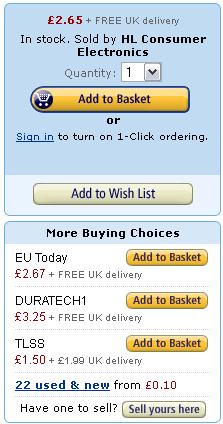 There can only be one winner and if you’re up against an Amazon stocked item or an FBA seller then the chances of you obtaining the buy box on equal total pricing, is remote.
There can only be one winner and if you’re up against an Amazon stocked item or an FBA seller then the chances of you obtaining the buy box on equal total pricing, is remote.
If there are multiple sellers that are eligible for the buy box, will rotate at differing speeds through the buy box and any sellers that are not in the main buy box are shown below.
If we look at the example to the right, then we have a winner that is at £2.65 + free delivery and three others with the same product at various prices, however the last one from TLSS is the one I’d like to point out in more detail next.
Note: If you’d like to know a formula that will get you access to the Amazon Buy box for longer, then see this article which gives you this and it’s proven to work and if you’d like to know more about Amazon’s “Seller Ratings”, the new scoring system for Amazon Sellers you can here.
I’m just a mere customer, not a mathematician.
In the buy box example above we’re given numerous options, but as a buyer I only really care about the total price and also I’m just a mere customer, not a mathematician.
Making a buyer think is a bad thing
If I’m presented with prices that all have free options, then I see the prices as the total price. However if you ask me to compare four prices on one set of terms, they’re all total prices with free shipping and you lob me a price that I need to calculate in my head, then you are making me think.
Trying sum up the prices so that I can either rule in the £1.50 plus £1.99 option when all the others are just prices with free shipping makes me think and making a buyer think is a bad thing.
We need to make it as easy as possible for them to work out if the proposition is a good one or not and if the playing field are using free shipping, then that is what you should follow, free shipping, otherwise we’re making the buyers think.
Considering Amazon Prime Users
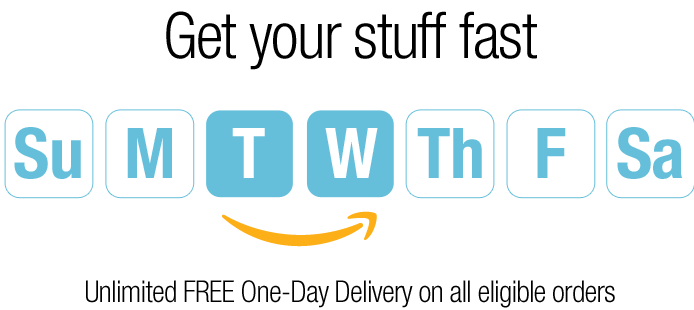 If we also account for Amazon Prime accounts, this is where an Amazon customer has paid £49 a year (or $79 in the USA) these are the power buyers on Amazon.
If we also account for Amazon Prime accounts, this is where an Amazon customer has paid £49 a year (or $79 in the USA) these are the power buyers on Amazon.
According to ChannelAdvisor’s Scot Wingo last year, there are approximately 10-12 million Amazon Prime users whom he also believes that these buyers account for a 3 to 4 times increase in buying volumes. As such they should not be ignored.
If we consider that it was you that paid £50 to have free next day delivery on items, then you’re not going to be that excited about paying extra for shipping when you’ve already stumped up £50 for an item on the Amazon marketplace where you’ve already made a decent outlay to get free shipping. In short as an Amazon Prime buyer you expect free shipping.
Note: You can gain access to these buyers by using FBA (Fulfilment By Amazon), this isn’t for everyone and doesn’t suit all products.
In Summary
Me me me me me me me me me me, that’s all the customer cares about. Using a quote from Seth Godin:
Customers want ME-MAIL not Email
So with me in mind (as a potential customer) I have a Amazon Prime subscription and trust me I hate paying postage on Amazon after paying £50 for free delivery and I know what the difference is between marketplace, FBA and Amazon stocked products are!!!!
I bet the vast majority of Amazon customers don’t and they just want simple pricing and the simplest it can be is price + free delivery.
While me and you may know that your postage prices are excellent, 99.9% of customers probably don’t know the latest price of a first class stamp (what is that now anyway?), let alone the different pricing bands from Royal Mail and whether your postage price is good value or not. They just want a total price.
If we consider the case for Christine, then if your competition are offering free delivery, then don’t make your buyers try and do maths, regardless of how simple it is. Customers are like babies, you need to keep it as simple as possible and spoon feed them just enough information so they get what they need to know at that moment in time.
Make it really easy for them and let them see that your total price is excellent.
Make it really easy for them and let them see that your total price is excellent. And if in doing so means you need to combine the shipping prices into the sell price and offer free shipping, then so be it.
In the original question from Christine, Christine was considering moving to a free shipping model on Amazon, the answer now with the explanation why, is yes you should move to a free shipping model on Amazon and I’ve hoped I’ve explained why.
Do You use Free Shipping on Amazon or Another Marketplace?
If you do and have seen a positive or a negative impact to doing so, let Christine know by leaving her a comment in the comments box at the bottom.







I kind of agree with what you are saying Matthew. However, if you search for a product the first thing a potential customer sees is the search results page listings all products matching the search.
For example, I searched for some men’s underwear called ‘Clever Moda’ and the search results listed about 20 items matching my search all on one page.
The search results only display the product price and give no indication of whether the shipping is free or not. Therefore, surely a potential customer is more likely than not to click on the product with the lowest product price and at this stage a seller wants to win that click because you are one step closer to closing the sale.
It is only when you win this click through to the product page that it becomes evident to the customer as to whether shipping is free or not.
If it is not free then in my view the customer has two choices; 1) exit and try another product to see if they can find one with free delivery, or 2) quickly decide if the shipping fee looks reasonable and fits in with his expectations of what shipping fees should be.
Now, in the test that I did with Clever Moda the majority were priced attractively and so won my initial click through to the product page. However, I quickly discovered that the shipping was priced far too high (in my opinion) at £4.95. In this case I personally would exit and look elsewhere.
Also, as a customer I am the sort of person who gets annoyed by being drawn in to buy something via what seems to be a good offer, to then only discover I am being charged over the odds for shipping in order to subsidise the low product price.
Had the price been under £3 at say £2.95, £2.75 or even £2.50 then I would more than likely have bought the product having said to myself, “this is the product I want, the product is at a good price and the postage is sensible”
Conclusion. I can see the pros and cons to both free shippings and reasonably priced shipping that does not offend the buyer. However, I do feel that as the shipping fee is not evident on the search result listings page, then it is the initial product price that is important on winning the click through to the product page. If you are still able to offer free shipping then that is a double bonus, but I think in most cases to offer a low product price to win the initial click will mean most sellers will have to charge shipping. I think the important point at this stage is to ensure the shipping looks sensible and does not offend.
KEEPING IT SIMPLE & NOT MAKING CUSTOMERS THINK
I totally agree with you on this and the logic in relation to this for offering free shipping as the customer only sees one nice and easy total price.
However, as mentioned, product price in IMO is key to winning the click, but if you then have to charge shipping to subsidise the low product price then I believe this can still be done by not having to make the customer think.
EXAMPLE.
As you described in your post the following product and shipping fees could put people off because they have to use there head – £11.99 + £2.21 shipping.
However, you could selling it as follows – £12 + £2 shipping.
The product price is competitive enough to with the initial click from the search results page, the shipping fee looks reasonable and the maths is not too difficult.
Excellent post. This has really made me re-think my approach to postage.
Hi Matt,
Excellent article! there is on thing i would like to point out is that when offering free shipping on Amazon the seller looses significant margin which could potentially be used to offer the customer a more reasonable price. This is by virtue of the higher VAT within the total list price.
Would agree with the above, as a buyer I only care about the total price and it’s much easier to see that when it’s free delivery!
I offered discounts on multiple items. As a result we have a larger than normal number of multiple items. Going to free shipping means we can no longer discount orders of 2 or more items. Is there a solution to this?
Howdy Vik,
Excellent question and just like Purity’s above, your feedback invaluable!
See the comment above for a note on the article, as it doesn’t suit all scenarios.
Is the order line items higher than you experience elsewhere? The reason why I ask, is that basket quantities differ from category to category. A business that sells make-up or craft items may have 10’s of items in the average order, but a business that sells TV’s, may struggle past one item.
Going to free shipping means we can no longer discount orders of 2 or more items. Is there a solution to this?
You’re absolutely right and this would be the case using free shipping, however you could easily use Amazon’s promotions tool and create a group for all or a subset of products and promote a discount that way, it might even help you bring the order quantities up higher too.
Let me dig out the details on this and I’ll post back when I find the forum post/comment/article (I know I’ve written it, just trying to find it).
Matt
Howdy Vik,
I had thought I covered that a while ago, I was right, but with a client last week and I’ve not documented it here.
The section you’re after is in Amazon Seller Central under:
Inventory > Manage Promotions
A direct link is here “Manage Promotions“, if you’re not on the Amazon UK site, swap the domain extension over (eg .co.uk to .com).
There are several promotion methods you can offer and I’ll cover these off properly in a full blown article of it’s own, but for now, dig in and see if this can help you.
A HUGE tip (as Amazon hide this bit) is to note that you can create “Product selections” (see here) and then apply one or more promotions to sub sets of your listings and you can manually pick which items are included too.
Does that help you and your business?
Matt
Interesting thoughts. One thing I don’t think considered is when customers buy multiple products (although I admit this is probably not as often). But I think we get up-sales because for each additional item we charge only an extra 50p – so it makes sense for the customer to buy multiple items to reduce the total cost of postage. If a customer wants more than “one” of an item, a customer is going to probably go with the cheaper price and pay the one off P&P.
Hola,
An excellent point and also highlights that this does not suit every category/business on Amazon, as if you products are unique then there is no-one to complete with on them with. Thus whether you include postage or not, if they want it they’ll pay for it.
The article is biased towards a specific group of products where there is competition for them and Amazon Fulfilled and there are numerous sellers using FBA.
However from a customers point of view, (and asking the question back to anyone), do we really think that the customer checks to see that they get discounted postage on additional items or after making the section for two or more items go through and check the postage because they might get a discounted rate, or do they just check out and accept the total price?
Matt
That’s really useful info, Matthew and I’m going to give it a try. It makes life easier for me too as a seller to keep it simple so i it seems the best option all round. I’ll keep you posted! Thank you